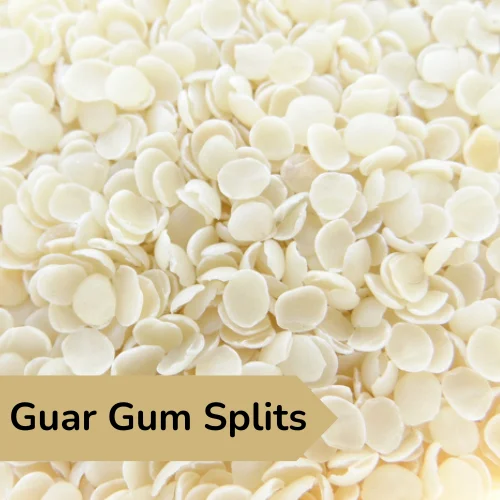Guar gum powder, derived from the seeds of the guar plant (Cyamopsis tetragonoloba), has become a vital ingredient in various industries. From food production to pharmaceuticals, cosmetics, and even the oil industry, guar gum is celebrated for its natural thickening, stabilizing, and emulsifying properties. But how exactly is guar gum powder made? This article delves into the step-by-step process of guar gum production, tracing its journey from the fields to its final powdered form.
1. Cultivation of Guar Plants
Guar gum begins its journey in the form of seeds from the guar plant, which is primarily grown in India and Pakistan. The guar plant thrives in semi-arid climates, making it suitable for regions with limited rainfall. Farmers sow the guar seeds during the rainy season, and the plant grows over a period of 3 to 4 months, producing pods that contain the guar seeds. These seeds are then harvested and dried.
2. Harvesting and Seed Cleaning
Once the guar plants have matured, they are harvested using traditional or mechanized methods. The harvested pods are dried under the sun to reduce moisture content. After drying, the pods are threshed to separate the seeds from the chaff. The guar seeds are then sent for further processing, but before that, they undergo thorough cleaning to remove any remaining dirt, husk, or impurities. Seed cleaning is crucial to ensure the quality of the final guar gum powder.
3. Dehusking and Splitting
The guar seeds consist of three layers: the outer husk, the endosperm, and the germ. The most valuable part of the seed for guar gum production is the endosperm, which contains galactomannan, a complex carbohydrate responsible for the thickening properties of guar gum.
In the dehusking process, the seeds are passed through specialized machines that remove the outer husk. After dehusking, the seeds are split into two halves, exposing the endosperm. The split seeds are further processed to separate the endosperm from the germ and other residual materials. This process is known as splitting, and it prepares the seeds for the next stage: refining.

4. Endosperm Separation
Once the seeds are split, the endosperm is carefully separated from the germ and other unwanted materials. This process is typically done through mechanical means such as grinding and sieving. The goal is to obtain the pure endosperm, which is the core ingredient for producing guar gum. This step is essential for maintaining the quality and consistency of the final product.
5. Milling
After the endosperm has been isolated, it is milled into a fine powder. Milling involves grinding the endosperm using various types of mills, such as pin mills, hammer mills, or roller mills. The milling process needs to be carefully controlled to achieve the desired particle size. Depending on the application, guar gum powder can be milled into different grades, ranging from coarse to ultrafine. Fine guar gum powder is commonly used in food processing, while coarser grades may be used in industrial applications.
6. Hydration and Modification
In some cases, the guar gum may undergo additional processing, such as hydration or chemical modification. Hydration is the process of adding water to the guar gum powder to enhance its viscosity and functional properties. This step is particularly important when guar gum is used in food and pharmaceutical applications, where a higher degree of viscosity is required.
Chemical modification may also be applied to alter the structure of the guar gum and improve its performance in specific applications, such as oil drilling or textile manufacturing.
7. Drying
Once the guar gum has been hydrated or modified, it is dried to remove any excess moisture. Drying can be done using hot air dryers or other drying techniques. The drying process ensures that the guar gum powder is stable and has a long shelf life. After drying, the powder is sieved to achieve uniform particle size and to remove any lumps or clumps that may have formed during processing.
8. Quality Control and Packaging
Quality control is an essential part of the guar gum production process. Samples of the guar gum powder are taken at various stages of production to ensure that the product meets the required specifications for viscosity, particle size, purity, and other parameters. Any batch that does not meet the quality standards is either reprocessed or discarded.
Once the guar gum powder passes the quality control tests, it is packaged in moisture-proof bags or containers to protect it from environmental factors such as humidity. Proper packaging ensures that the guar gum powder remains free-flowing and retains its functional properties for an extended period.
9. Storage and Distribution
The final stage in the guar gum production process is storage and distribution. Guar gum powder is stored in temperature-controlled warehouses to prevent any degradation of its quality. From there, it is distributed to various industries worldwide, where it is used in everything from food production to oil drilling, pharmaceuticals, and cosmetics.
Applications of Guar Gum Powder
Guar gum powder has a wide range of applications across different industries:
- Food industry: Used as a thickener, stabilizer, and emulsifier in products like ice cream, sauces, and bakery goods.
- Pharmaceuticals: Used as a binder and disintegrant in tablets.
- Cosmetics: Used in lotions, creams, and shampoos for its thickening properties.
- Oil and gas industry: Used in hydraulic fracturing (fracking) to increase the viscosity of drilling fluids.
- Textile and paper industries: Used as a sizing agent and stabilizer.
FAQs About Guar Gum Powder
Conclusion
The process of making guar gum powder is a meticulous one, involving several stages from cultivation to milling, hydration, and drying. With its wide-ranging applications across numerous industries, guar gum powder remains a highly versatile and sought-after natural ingredient. Whether used in food, pharmaceuticals, or industrial applications, its production process ensures that the end product meets high standards of quality and functionality.
Web Design & Digital Marketing by Opal Infotech

